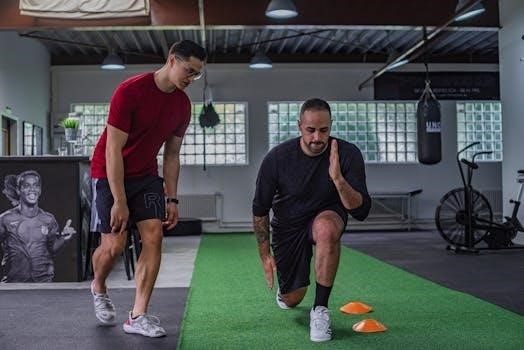What is Conjugate Training?
The Conjugate Method‚ popularized by Louie Simmons of Westside Barbell‚ is a powerlifting training approach. It focuses on developing strength by varying exercises. It trains multiple athletic traits weekly‚ avoiding detraining and promoting well-rounded development.

The Core Principles of the Conjugate Method
The Conjugate Method revolves around three core principles to maximize strength gains and athletic performance. These include the Max Effort (ME) method‚ Dynamic Effort (DE) method‚ and the Repetition Effort (RE) method‚ each with a specific role.
Max Effort (ME) Method
The Max Effort (ME) method is a cornerstone of the Conjugate system‚ focusing on building absolute strength. It involves lifting maximal loads‚ typically above 90% of your one-repetition maximum (1RM)‚ on a specific exercise. The goal is to stimulate the high-threshold fast-twitch muscle fibers‚ crucial for power and strength development. However‚ it’s important to avoid attempting lifts that are so heavy that assistance is needed‚ as this can be counterproductive.
ME days typically involve selecting a main lift variation and working up to a new 1RM or a near-maximal single. Exercise selection is rotated regularly‚ often weekly‚ to prevent accommodation and target different muscle groups and movement patterns. This variation is crucial for continuous progress and avoiding plateaus. Examples include variations of squats‚ bench presses‚ and deadlifts‚ often incorporating specialty bars‚ bands‚ or chains to further challenge the lifter. Proper warm-up and progressive loading are essential to minimize the risk of injury during ME training.
Dynamic Effort (DE) Method
The Dynamic Effort (DE) method focuses on developing speed and explosiveness. It involves lifting submaximal weights‚ typically between 50-80% of 1RM‚ with the intent to move the weight as quickly as possible. The key is to emphasize bar speed and acceleration throughout the entire range of motion. This method helps improve the rate of force development‚ which is crucial for athletic performance.
DE days typically involve performing multiple sets of low repetitions (e.g.‚ 8 sets of 2 reps or 10 sets of 3 reps) with a focus on maximal bar speed. Resistance bands and chains are often incorporated to increase the challenge at the top of the lift and further enhance speed development. Exercise selection is also rotated regularly‚ similar to the ME method‚ to prevent accommodation and target different aspects of speed and power. Proper technique and controlled movements are essential to minimize the risk of injury while maximizing the benefits of DE training.
Repetition Effort (RE) Method
The Repetition Effort (RE) method aims to build muscle mass and improve muscular endurance. It involves performing exercises to muscular failure with moderate weights. The goal is to accumulate a high volume of work to stimulate hypertrophy and enhance the ability to perform repeated contractions. RE work often focuses on accessory exercises that target specific muscle groups and address weaknesses identified in the main lifts.
Typical RE sets involve performing 8-12 repetitions or more to failure. The exercises chosen should complement the main lifts and target areas that need improvement. For example‚ if an athlete struggles with lockout strength in the bench press‚ triceps extensions and close-grip bench presses would be beneficial RE exercises. The volume and intensity of RE work should be adjusted based on the individual’s training goals and recovery capabilities. Proper form and controlled movements are essential to prevent injury during higher repetition sets.
Benefits of Conjugate Training
Conjugate training offers diverse benefits‚ making it a popular choice for strength athletes. A primary advantage is continuous progress by training all strengths relevant to athletic performance each week. This method prevents detraining. It stimulates consistent gains in strength‚ speed‚ work capacity‚ and durability. The constant variation in exercises and intensity helps to avoid plateaus and keeps training engaging. The conjugate method’s focus on addressing weaknesses leads to more balanced and robust strength development. By targeting specific areas with accessory work‚ athletes can overcome limitations that hinder their main lifts.
This approach promotes a more resilient and injury-resistant physique. Furthermore‚ the conjugate method’s flexibility allows for adjustments based on individual needs and goals. It can be adapted to various training schedules and equipment availability. Whether the goal is powerlifting‚ strongman‚ or general strength enhancement‚ conjugate training provides a versatile and effective framework for achieving results.
Who is Conjugate Training For?
Conjugate training suits athletes seeking consistent progress across strength‚ speed‚ and work capacity. It’s ideal for those comfortable with complex programming and varying exercises‚ adaptable to different training goals and schedules.
Experience Level Required
Conjugate training isn’t typically for complete beginners. A foundation in basic strength training principles is helpful. Ideally‚ individuals should have a few years of consistent training experience. They need to be familiar with various exercises and understand proper form.
Prior experience with max effort‚ dynamic effort‚ and repetition effort methods is beneficial. Understanding how to assess and adjust training based on feedback is crucial. Conjugate training involves more autoregulation than linear programs.
Beginners might find the complexity overwhelming. They may lack the body awareness to make informed exercise selections. It’s best to establish a solid base with simpler programs first. Then‚ gradually transition to conjugate training as experience grows. Working with a coach familiar with conjugate methods is highly recommended for those with limited experience to ensure proper implementation and technique.
Time Commitment
Conjugate training demands a significant time commitment. Athletes should dedicate at least four to five hours per week. This time is needed to accommodate the multiple training sessions. These sessions are often divided into max effort‚ dynamic effort‚ and repetition effort work.
Each session typically includes main lifts and accessory exercises. Accessory work is crucial for addressing weaknesses and building overall strength. Proper warm-up and cool-down routines also add to the total time.
Consistent attendance is vital for progress. The conjugate method relies on regular variation and adaptation. Missing sessions can disrupt the training cycle. It can hinder the ability to effectively monitor progress. Individuals with limited time might find it challenging to fully benefit from the conjugate approach. Careful scheduling and prioritization are essential for success.

Components of a Conjugate Training Program
A Conjugate program incorporates main lifts‚ focusing on max and dynamic effort. Accessory work addresses weaknesses and builds muscle endurance. Exercise selection varies regularly to avoid accommodation and promote continuous progress in all areas of strength.
Main Lifts
Within a Conjugate training program‚ main lifts are crucial. They involve variations of the squat‚ bench press‚ and deadlift. These variations are rotated regularly‚ often weekly‚ to prevent accommodation and target specific strength weaknesses. On Max Effort days‚ the goal is to lift the heaviest possible weight for a single repetition‚ or a near-maximal weight for a few repetitions‚ focusing on absolute strength development.
Dynamic Effort days emphasize speed and explosiveness‚ using lighter weights (typically 50-80% of 1RM) and focusing on moving the weight as quickly as possible. Bands and chains are often used to accommodate the strength curve‚ providing increasing resistance as the lift progresses. This helps develop rate of force development and explosive power.
The selection of main lift variations should be based on individual weaknesses and training goals‚ ensuring a well-rounded approach to strength development.
Accessory Work
Accessory work in a Conjugate training program is vital for building muscle‚ addressing weaknesses‚ and preventing injuries. It typically comprises a larger portion of the overall training volume. Unlike main lifts‚ accessory exercises are generally performed for higher repetitions and sets. The selection of exercises should complement the main lifts and target specific muscle groups or movement patterns.
Upper body accessory work may include exercises like dumbbell presses‚ rows‚ pull-ups‚ and shoulder raises. Lower body exercises may involve good mornings‚ reverse hyperextensions‚ glute-ham raises‚ and single-leg work. Core exercises are also essential for stability and injury prevention.
The Conjugate method allows for frequent rotation of accessory exercises‚ preventing plateaus and maintaining training stimulus. Proper selection and execution of accessory work are crucial for maximizing the benefits of the program.

Conjugate Method Program Examples
Several templates exist to illustrate Conjugate Method programming. These examples range from shorter six-week plans to more extensive sixteen-week programs. These showcase the practical application of Max Effort‚ Dynamic Effort‚ and Repetition Effort principles.
6-Week Sample Template
This six-week sample template provides a basic framework for implementing the Conjugate Method. It simplifies the programming aspect by outlining the Main Move variation on Max Effort and Dynamic Effort days. This template serves as an introductory guide to understanding how to structure a Conjugate program. It allows lifters to experience the core principles without immediate complexity. It’s crucial to remember that this is a sample‚ and individual adjustments are expected. Factors like experience level and specific goals should influence exercise selection and intensity.
Consider this template a starting point to be adapted based on personal needs and progress. Remember to track your performance and make necessary modifications. This approach ensures the program remains effective and aligned with your individual strength goals. Accessory exercises should supplement the main lifts and address individual weaknesses.
16-Week Program by Brian Alsruhe
Brian Alsruhe’s 16-week program is a comprehensive‚ four-day-per-week strength training plan. It uses conjugate methods‚ specifically dynamic and max effort‚ to stimulate strength gains. The program heavily incorporates resistance bands and chains to enhance the training effect. It is designed for intermediate to advanced lifters seeking structured progression. The program balances main lifts with targeted accessory work to address individual weaknesses. Alsruhe’s program provides a detailed roadmap for strength development over an extended period.
The program is structured to peak strength‚ making it suitable for powerlifting or strongman athletes. Athletes should be familiar with the conjugate method principles before starting. The emphasis on bands and chains requires access to specialized equipment. Adjustments can be made‚ but familiarity with conjugate programming is recommended.

Adapting Conjugate Training for Different Goals
The Conjugate Method’s versatility allows adaptation for diverse goals beyond powerlifting. Adjust exercise selection and training volume. For general strength and conditioning‚ prioritize compound movements and moderate rep ranges. To improve athletic performance‚ incorporate sport-specific exercises and explosive movements. Focus on speed and power development. For hypertrophy‚ increase training volume and emphasize muscle-building exercises. Accessory work should target specific muscle groups.
Modify the frequency of max effort‚ dynamic effort‚ and repetition effort days. To improve work capacity‚ include conditioning work alongside strength training. This could include aerobic exercises or strongman implements. The key is to align the training program with the desired outcome. The system’s flexibility accommodates various needs and experience levels.
Common Mistakes in Conjugate Training
Several pitfalls can hinder progress in Conjugate Training. One common mistake is inconsistent exercise variation‚ leading to accommodation. Regularly rotate main lifts and accessory exercises. Another error is neglecting proper technique‚ increasing injury risk. Prioritize form over weight‚ especially on max effort days. Ignoring individual weaknesses is also detrimental. The Conjugate Method is designed to address weak points‚ so tailor accessory work accordingly. Overlooking recovery is another issue. Adequate rest and nutrition are crucial for adaptation and preventing overtraining.
Failing to track progress and adjust programming hinders optimization. Monitor performance and adapt the program. Neglecting dynamic effort training limits speed and power development. Ensure proper technique and appropriate loads. Finally‚ not understanding the principles can lead to ineffective programming. Educate yourself on the core concepts.
Resources for Conjugate Training Programs
Finding reliable Conjugate Training programs is crucial for success. Westside Barbell’s website and books are primary resources‚ offering insights into Louie Simmons’ methods. Online platforms like Lift Vault provide curated program libraries‚ including Conjugate variations. Brian Alsruhe’s YouTube channel and website offer detailed program examples and explanations.
Consider seeking guidance from experienced Conjugate coaches. They provide personalized programming and technique feedback. Powerlifting communities and forums offer valuable insights and program recommendations. Explore resources from StrongFirst‚ connecting Conjugate principles with strength training. Remember to critically evaluate resources and adapt programs. Prioritize safety and individual needs when selecting and implementing a Conjugate Training program.

